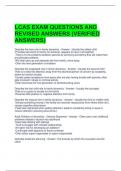Exam (elaborations)
LCAS EXAM QUESTIONS AND REVISED ANSWERS (VERIFIED ANSWERS)
- Course
- Institution
LCAS EXAM QUESTIONS AND REVISED ANSWERS (VERIFIED ANSWERS) Describe the hero role in family dynamics - Answer- -Usually the oldest child -Provides self-worth to family (an achiever, appears to have it all together) -Tries to fix the problems between parents by achieving something that will mak...
[Show more]



